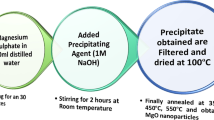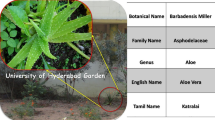Abstract
A novel heterogeneous catalyst Fe3O4@SB@Cu that contains a copper(II) Schiff base complex covalently immobilised on Fe3O4 nanoparticles was synthesised. The prepared catalyst is well characterised by FTIR spectroscopy, UV–Visible spectroscopy, FE-SEM, TEM, VSM analysis, EDX, XRD analysis, TGA, CV technique, XPS and PL studies to confirm its structural and morphological features. The high BET surface area (117.34 m2/g) was achieved for particles with size 25–30 nm and saturation magnetisation of 43.4 emu/g. The catalytic potential of the synthesised catalyst Fe3O4@SB@Cu was investigated by employing H2O2 as an oxidant for the oxidation of anthracene to anthraquinone. Various parameters like catalytic loading, temperature and solvents were varied to determine the optimal catalytic conditions, and 96% yield of the product is obtained within 36 min when the reaction was performed in the acetonitrile solvent with 1.8% loading of the catalyst. The catalytic reaction was monitored by UV–Visible spectroscopy. Using an external magnet, the modified nanoparticles were easily retrieved from the reaction mixture and can be utilised for five more reaction cycles without the significant loss of activity or copper leaching.
Graphical Abstract






















Similar content being viewed by others
References
Taboonpong P, Chavasiri W (2018) CuCl2/[hmim]Br: a new recyclable catalytic system for aromatization of cyclic dienes. Catal Commun 104:9–12. https://doi.org/10.1016/j.catcom.2017.10.009
Kim H, il, Choi Y, Hu S, et al (2018) Photocatalytic hydrogen peroxide production by anthraquinone-augmented polymeric carbon nitride. Appl Catal B 229:121–129. https://doi.org/10.1016/j.apcatb.2018.01.060
Rodríguez-Gómez A, Platero F, Caballero A, Colón G (2018) Improving the direct synthesis of hydrogen peroxide from hydrogen and oxygen over Au-Pd/SBA-15 catalysts by selective functionalization. Mol Catal 445:142–151. https://doi.org/10.1016/j.mcat.2017.10.034
Bai H, Fang X, Peng C (2019) Novel working solvent for the production of hydrogen peroxide. Ind Eng Chem Res 58:6948–6956. https://doi.org/10.1021/acs.iecr.9b01130
Guo Y, Dai C, Lei Z et al (2016) Synthesis of hydrogen peroxide over Pd/SiO2/COR monolith catalysts by anthraquinone method. Catal Today 276:36–45. https://doi.org/10.1016/j.cattod.2016.03.023
Lai IC, Lee CL, Zeng KY, Huang HC (2011) Seasonal variation of atmospheric polycyclic aromatic hydrocarbons along the Kaohsiung coast. J Environ Manage 92:2029–2037. https://doi.org/10.1016/j.jenvman.2011.03.026
Alwi RS, Tamura K (2015) Measurement and correlation of derivatized anthraquinone solubility in supercritical carbon dioxide. J Chem Eng Data 60:3046–3052. https://doi.org/10.1021/acs.jced.5b00480
Shayanfar A, Eghrary SH, Sardari F et al (2011) Solubility of anthracene and phenanthrene in ethanol + 2,2,4- trimethylpentane mixtures at different temperatures. J Chem Eng Data 56:2290–2294. https://doi.org/10.1021/je101272u
Lu Z, He F, Hsieh CY et al (2019) Magnetic hierarchical photocatalytic nanoreactors: toward highly selective Cd2+ removal with secondary pollution free tetracycline degradation. ACS Appl Nano Mater 2:1664–1674. https://doi.org/10.1021/acsanm.9b00113
Li C, Hui B, Ye L (2018) Construction of polyurethane-imide/graphene oxide nanocomposite foam with gradient structure and its thermal mechanical stability. Ind Eng Chem Res 57:13742–13752. https://doi.org/10.1021/acs.iecr.8b02911
Roostaee M, Sheikhshoaie I (2020) Magnetic nanoparticles; synthesis, properties and electrochemical application: a review. Curr Biochem Eng 6:91–102. https://doi.org/10.2174/2212711906666200316163207
Nasrollahzadeh M, Issaabadi Z, Safari R (2019) Synthesis, characterization and application of Fe3O4@SiO2 nanoparticles supported palladium(II) complex as a magnetically catalyst for the reduction of 2,4-dinitrophenylhydrazine, 4-nitrophenol and chromium(VI): a combined theoretical (DFT) and experiment. Sep Purif Technol 209:136–144. https://doi.org/10.1016/j.seppur.2018.07.022
Yin SJ, Zhao CP, Jiang H et al (2021) Preparation of amino-functionalized covalent organic framework modified Fe3O4 nanoparticles for the selective enrichment of flavonoid glycosides. Microchem J 164:105990. https://doi.org/10.1016/j.microc.2021.105990
Koo KN, Ismail AF, Othman MHD et al (2019) Preparation and characterization of superparamagnetic magnetite (Fe3O4) nanoparticles: a short review. Mal J Fund Appl Sci 15:23–31. https://doi.org/10.11113/mjfas.v15n2019.1224
Maleki H, Rakhtshah J, Shaabani B (2020) Effective one-pot synthesis of tetrahydrobenzo[b]pyran derivatives using nickel Schiff-base complex immobilized on iron oxide nanoparticles. Appl Organomet Chem 34:1–15. https://doi.org/10.1002/aoc.5683
Bezaatpour A, Payami F, Eskandari H (2017) Green, inexpensive, and fast conversion of sulfides to sulfoxides by multiusable Mo(VI) macrocyclic Schiff base complex supported on Fe3O4 nanoparticles in solvent-free conditions. C R Chim 20:910–920. https://doi.org/10.1016/j.crci.2017.07.004
Eshaghi Malekshah R, Fahimirad B, Aallaei M, Khaleghian A (2020) Synthesis and toxicity assessment of Fe3O4 NPs grafted by ∼ NH2-Schiff base as anticancer drug: modeling and proposed molecular mechanism through docking and molecular dynamic simulation. Drug Deliv 27:1201–1217. https://doi.org/10.1080/10717544.2020.1801890
Reghioua A, Barkat D, Jawad AH et al (2021) Synthesis of Schiff’s base magnetic crosslinked chitosan-glyoxal/ZnO/Fe3O4 nanoparticles for enhanced adsorption of organic dye: modeling and mechanism study. Sustain Chem Pharm 20:100379. https://doi.org/10.1016/j.scp.2021.100379
Zhao J, Niu Y, Ren B et al (2018) Synthesis of Schiff base functionalized superparamagnetic Fe3O4 composites for effective removal of Pb(II) and Cd(II) from aqueous solution. Chem Eng J 347:574–584. https://doi.org/10.1016/j.cej.2018.04.151
Kapila A, Kaur M, Kaur H (2020) Materials today : proceedings organotin (IV) complexes of tridentate (O, N, O) Schiff base ligand : computational, spectroscopic and biological studies. Mater Today Proc. https://doi.org/10.1016/j.matpr.2020.04.080
Sidana N, Kaur M, Kaur H, Devi P (2020) Pyrrole-based Schiff-base sensor for copper ions. ChemistrySelect. https://doi.org/10.1002/slct.202003701
More MS, Joshi PG, Mishra YK, Khanna PK (2019) Metal complexes driven from Schiff bases and semicarbazones for biomedical and allied applications: a review. Mater Today Chem 14:100195. https://doi.org/10.1016/j.mtchem.2019.100195
Al Zoubi W, Al-Hamdani AAS, Kaseem M (2016) Synthesis and antioxidant activities of Schiff bases and their complexes: a review. Appl Organomet Chem 30:810–817. https://doi.org/10.1002/aoc.3506
Salih KSM, Shraim AM, Al-Mhini SR et al (2021) New tetradentate Schiff base Cu(II) complexes: synthesis, physicochemical, chromotropism, fluorescence, thermal, and selective catalytic oxidation. Emergent Mater 4:423–434. https://doi.org/10.1007/s42247-021-00183-9
Kaur M, Sahoo SC, Kaur H (2020) New Schiff base as selective and sensitive detection of copper ions in aqueous solvent. ChemistrySelect. https://doi.org/10.1002/slct.202003880
Iftikhar B, Javed K, Khan MSU et al (2018) Synthesis, characterization and biological assay of salicylaldehyde Schiff base Cu(II) complexes and their precursors. J Mol Struct 1155:337–348. https://doi.org/10.1016/j.molstruc.2017.11.022
Silva TFS, Martins LMDRS (2020) Recent advances in copper catalyzed alcohol oxidation in homogeneous medium. Molecules 25:1–15. https://doi.org/10.3390/molecules25030748
Thabet RH, Tony MA, El Sherbiny SA et al (2020) Catalytic oxidation over nanostructured heterogeneous process as an effective tool for environmental remediation. IOP Conf Ser Mater Sci Eng. https://doi.org/10.1088/1757-899X/975/1/012004
Adam MSS, Al-Omair MA (2020) Nanocomposite-based inorganic-organocatalyst Cu(II) complex and SiO2- and Fe3O4 nanoparticles as low-cost and efficient catalysts for aniline and 2-aminopyridine oxidation. Appl Organomet Chem 34:1–22. https://doi.org/10.1002/aoc.5999
Veisi H, Rashtiani A, Rostami A et al (2019) Chemo-selective oxidation of sulfide to sulfoxides with H2O2 catalyzed by oxo-vanadium/Schiff-base complex immobilized on modified magnetic Fe3O4 nanoparticles as a heterogeneous and recyclable nanocatalyst. Polyhedron 157:358–366. https://doi.org/10.1016/j.poly.2018.09.034
Bhat PB, Bhat BR (2015) Nano Fe3O4@APTES@Ni(OH)2 as a catalyst for alcohol oxidation. New J Chem 39:273–278. https://doi.org/10.1039/c4nj01649a
Wang L, Shen C, Cao Y (2019) PVP modified Fe3O4@SiO2 nanoparticles as a new adsorbent for hydrophobic substances. J Phys Chem Solids 133:28–34. https://doi.org/10.1016/j.jpcs.2019.05.004
Mahmoudi-GomYek S, Azarifar D, Ghaemi M et al (2019) Fe3O4-supported Schiff-base copper (II) complex: a valuable heterogeneous nanocatalyst for one-pot synthesis of new pyrano[2,3-b]pyridine-3-carboxamide derivatives. Appl Organomet Chem 33:1–14. https://doi.org/10.1002/aoc.4918
Kaur M, Kumar P, Gupta A et al (2021) Sn coated Fe3O4 nanoparticles for selective and efficient oxidation of anthracene to anthraquinone. Mater Lett. https://doi.org/10.1016/j.matlet.2021.130643
Ebrahimiasl H, Azarifar D (2020) Copper-based Schiff base complex immobilized on core-shell Fe3O4@SiO2 as a magnetically recyclable and highly efficient nanocatalyst for green synthesis of 2-amino-4H-chromene derivatives. Appl Organomet Chem 34:1–20. https://doi.org/10.1002/aoc.5359
Sarkheil M, Lashanizadegan M (2017) Copper(II) Schiff base complex immobilized on superparamagnetic Fe3O4@SiO2 as a magnetically separable nanocatalyst for oxidation of alkenes and alcohols. Appl Organomet Chem 31:1–8. https://doi.org/10.1002/aoc.3726
Rakhtshah J, Yaghoobi F (2019) Catalytic application of new manganese Schiff-base complex immobilized on chitosan-coated magnetic nanoparticles for one-pot synthesis of 3-iminoaryl-imidazo[1,2-a]pyridines. Int J Biol Macromol 139:904–916. https://doi.org/10.1016/j.ijbiomac.2019.08.054
Dindarloo Inaloo I, Majnooni S, Eslahi H, Esmaeilpour M (2020) Nickel(II) nanoparticles immobilized on EDTA-modified Fe3O4@SiO2 nanospheres as efficient and recyclable catalysts for ligand-free Suzuki-Miyaura coupling of aryl carbamates and sulfamates. ACS Omega 5:7406–7417. https://doi.org/10.1021/acsomega.9b04450
Zhuang Y, Liu J, Yuan S et al (2020) Degradation of octane using an efficient and stable core-shell Fe3O4@C during Fenton processes: enhanced mass transfer, adsorption and catalysis. Appl Surf Sci 515:146083. https://doi.org/10.1016/j.apsusc.2020.146083
Sekhar DC, Diwakar BS, Madhavi N (2019) Synthesis, characterization and anti-bacterial screening of complex nanocomposite structures of SiO2@ZnO@Fe3O4 and SnO2@ZnO@Fe3O4. Nano-Struct Nano-Objects. https://doi.org/10.1016/j.nanoso.2019.100374
Bandar S, Anbia M, Salehi S (2021) Comparison of MnO2 modified and unmodified magnetic Fe3O4 nanoparticle adsorbents and their potential to remove iron and manganese from aqueous media. J Alloys Compd. https://doi.org/10.1016/j.jallcom.2020.156822
Lou C, Jing T, Tian J et al (2019) 3-Dimensional graphene/Cu/Fe3O4 composites: immobilized laccase electrodes for detecting bisphenol A. J Mater Res 34:2964–2975. https://doi.org/10.1557/jmr.2019.248
Kohzadi H, Soleiman-Beigi M (2021) XPS and structural studies of Fe3O4-PTMS-NAS@Cu as a novel magnetic natural asphalt base network and recoverable nanocatalyst for the synthesis of biaryl compounds. Sci Rep. https://doi.org/10.1038/s41598-021-04111-z
Ebrahimiasl H, Azarifar D (2020) Copper-based Schiff base complex immobilized on core-shell Fe3O4@SiO2 as a magnetically recyclable and highly efficient nanocatalyst for green synthesis of 2-amino-4H-chromene derivatives. Appl Organomet Chem. https://doi.org/10.1002/aoc.5359
Raha S, Ahmaruzzaman M (2020) Facile fabrication of g-C3N4 supported Fe3O4 nanoparticles/ZnO nanorods: a superlative visible light responsive architecture for express degradation of pantoprazole. Chem Eng J 387:123766. https://doi.org/10.1016/j.cej.2019.123766
Cai W, Guo M, Weng X et al (2020) Modified green synthesis of Fe3O4@SiO2 nanoparticles for pH responsive drug release. Mater Sci Eng C. https://doi.org/10.1016/j.msec.2020.110900
Pham VL, Kim DG, Ko SO (2018) Oxidative degradation of the antibiotic oxytetracycline by Cu@Fe3O4 core-shell nanoparticles. Sci Total Environ 631–632:608–618. https://doi.org/10.1016/j.scitotenv.2018.03.067
Ni Z, Zhang C, Wang Z et al (2021) Performance and potential mechanism of transformation of polycyclic aromatic hydrocarbons (PAHs) on various iron oxides. J Hazard Mater. https://doi.org/10.1016/j.jhazmat.2020.123993
Kaur M, Kapila A, Yempally V, Kaur H (2022) Synthesis, structural elucidation, and catalytic activity of bimetallic rhenium-tin complexes containing Schiff base ligand. J Mol Struct. https://doi.org/10.1016/j.molstruc.2021.131545
Acknowledgements
Megha gratefully acknowledges PEC and MHRD for providing GATE fellowship. SAIF/CIL lab, Panjab University is acknowledged for characterization facilities.
Author information
Authors and Affiliations
Contributions
M: Methodology, Data curation, Investigation, Writing—original draft. MK: Data curation, Writing—original draft, Conceptualization. D: Data curation, Investigation, Conceptualization. VY: Writing—review & editing, Conceptualization, Investigation. HK: Supervision, Resources, Writing—review & editing.
Corresponding author
Ethics declarations
Conflict of interests
The authors declare that they have no known conflict of interests or personal relationships that could have appeared to influence the work reported in this paper.
Additional information
Publisher's Note
Springer Nature remains neutral with regard to jurisdictional claims in published maps and institutional affiliations.
Rights and permissions
Springer Nature or its licensor (e.g. a society or other partner) holds exclusive rights to this article under a publishing agreement with the author(s) or other rightsholder(s); author self-archiving of the accepted manuscript version of this article is solely governed by the terms of such publishing agreement and applicable law.
About this article
Cite this article
Megha, Kaur, M., Diksha et al. Copper(II) Schiff Base Complex Immobilized on Magnetic-Fe3O4 Nanoparticles for Selective Oxidation of Anthracene. Catal Lett 154, 2606–2619 (2024). https://doi.org/10.1007/s10562-023-04505-w
Received:
Accepted:
Published:
Issue Date:
DOI: https://doi.org/10.1007/s10562-023-04505-w




